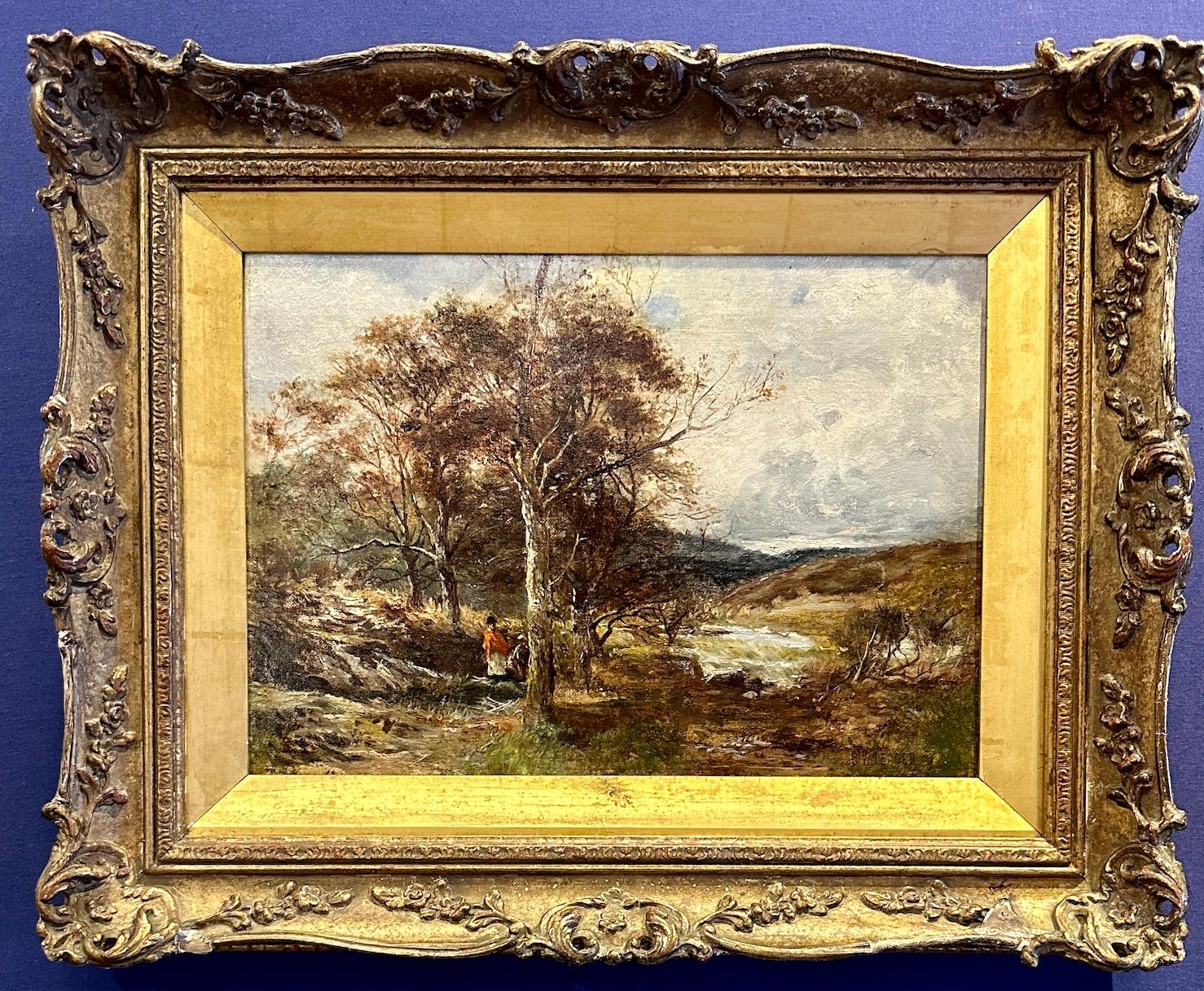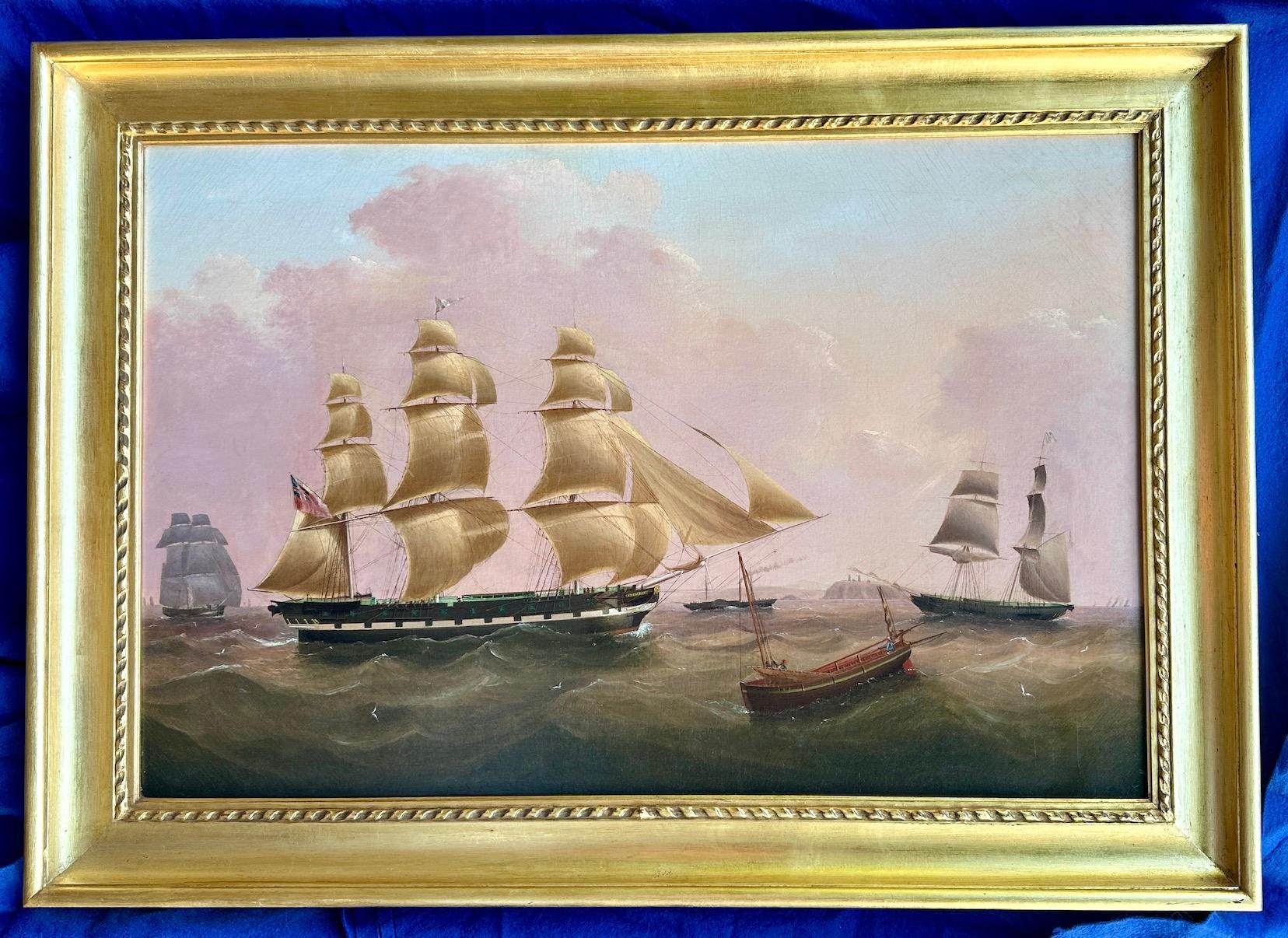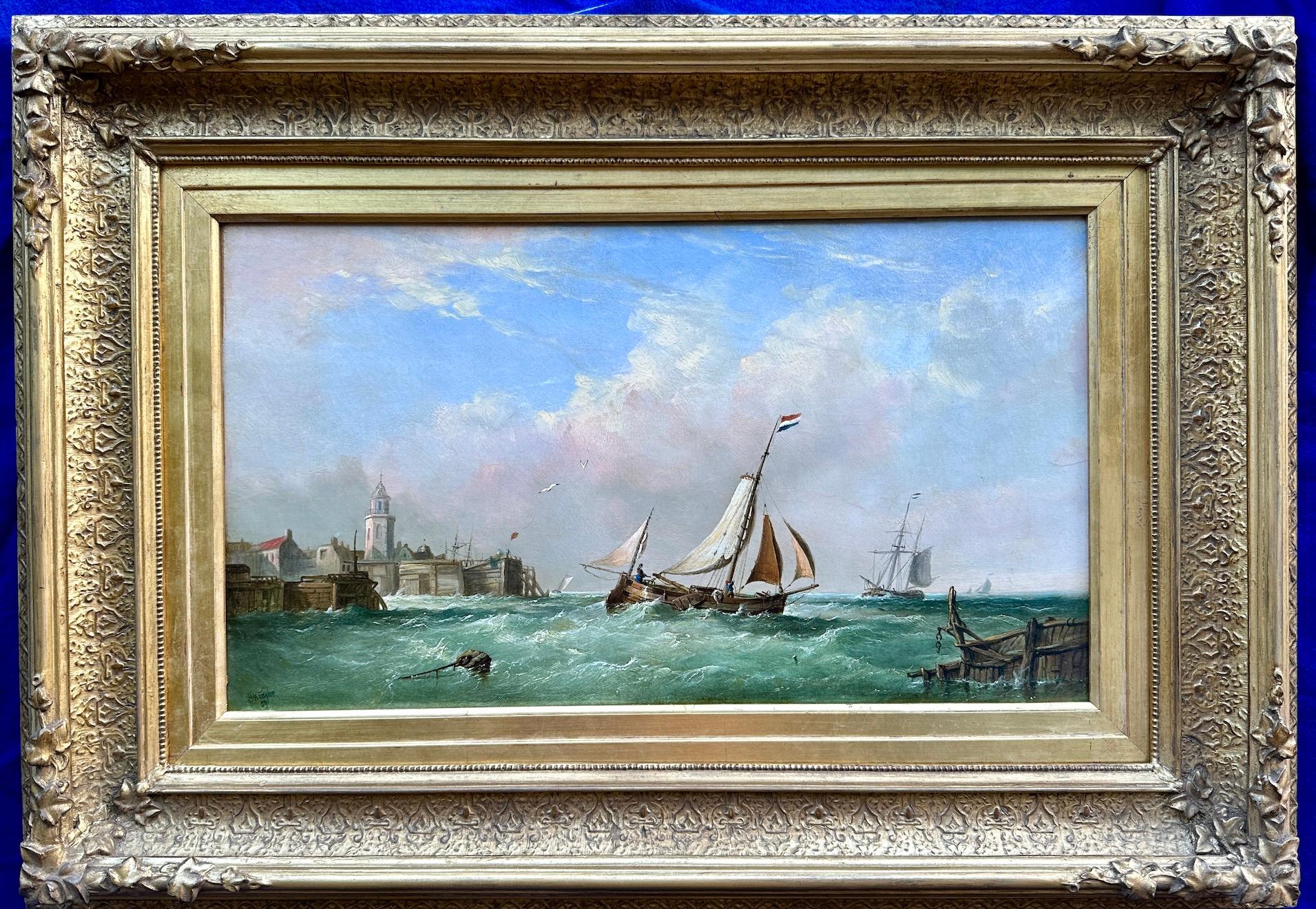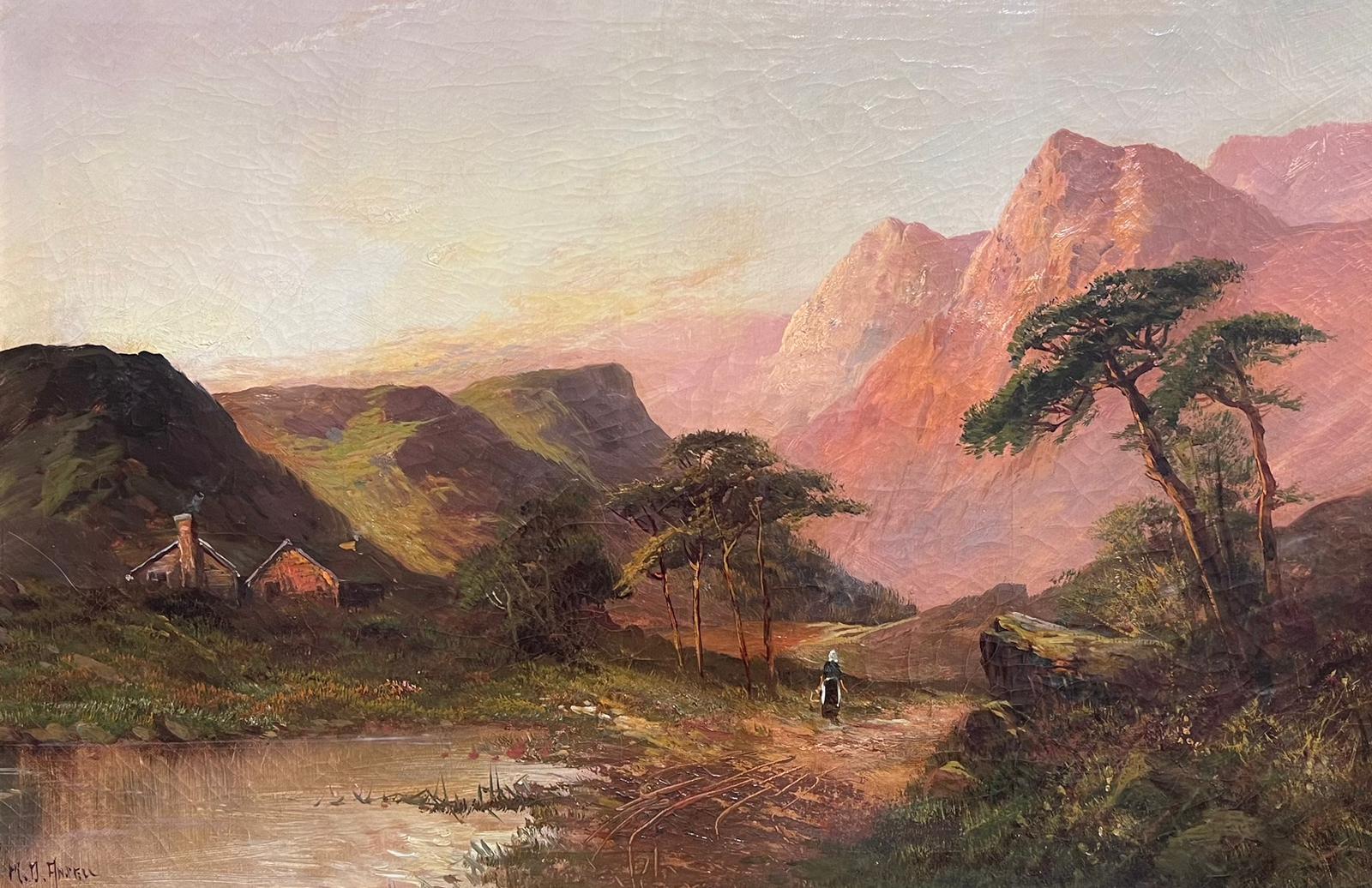Items Similar to Making the Run for Home, Cornish Coast. Cornwall. Sail Fishing Boat. Pilchards.
Want more images or videos?
Request additional images or videos from the seller
1 of 24
Charles Napier HemyMaking the Run for Home, Cornish Coast. Cornwall. Sail Fishing Boat. Pilchards.1915
1915
About the Item
Charles Napier Hemy.
English ( b.1841 – d.1917 ).
Making the Run for Home, Cornish Coast. 1915
Oil on Canvas.
Monogram & dated 1915 lower right.
Image size 19.5 inches x 29.5 inches ( 49.5cm x 75cm ).
Frame size 25.6 inches x 35.6 inches ( 65cm x 90.5cm ).
Available for sale; this original oil painting is by the marine artist Charles Napier Hemy and is dated 1915.
The painting is presented and supplied in a sympathetic frame and mount dating from the 1960s or 1970s.
The painted surface and canvas have been restored and cleaned whilst in previous ownership. The canvas is lined. We are of the opinion that this work was performed in the 1960s or 1970s and correlates with the frame’s age.
Today, this antique painting is in good condition as a result of the previous work. It is supplied ready to hang and display.
The painting is signed and dated lower right.
Charles Napier Hemy, possibly the finest British marine artist of his generation, is known for his works in the Tate collections. He had a life that was particularly interesting, fulfilling and professionally successful.
He was born at Newcastle upon Tyne on 24 May 1841, the eldest son of a composer. His two younger brothers also became artists, although neither achieved the success of Charles.
In 1850 his parents had run into financial difficulties, so the Hemys emigrated to Australia, aboard a ship named the Madawaska. His mother gave birth to his youngest brother whilst on the journey. For Charles, then just a nine-year-old boy, this was an epic voyage and the return voyage in 1852 marked the start for him of a love affair with boats and the sea: He later wrote “It was imprinted on my mind and I never forgot it”. Whilst in Australia Charles’ father tired his hand at gold prospecting, assisted by young Charles, but the family found it the life very tough, especially with three young boys, and so they returned to England. The small amount of gold they had prospected however enabled them to settle their debts and resume a decent life.
Charles had a strong artistic interest, and at 13 he enrolled in Newcastle’s Government School of Design under the tutelage of William Bell Scott. During his teenage years Charles also worked briefly on the sea, with two stints sailing on merchant vessels.
Charles was a deeply spiritual man and a lifelong and devout Catholic. In the mid 1850s he decided to enter the priesthood and spent three years as a monk in a Dominican House, at Newcastle upon Tyne, and in a monastery in Lyons, France. He painted in his spare time, working on church decorations. This love of painting caused him to reconsider life as a priest and, rather than taking his final vows, he took up painting professionally. He went to Antwerp and studied under H Leys from 1867-1870, where he painted historical scenes. In 1870 he settled in London, where he was much influenced by Whistler. From 1870-80 he worked from a studio in Fulham and in the William Morris workshop, where he was greatly influenced by the Pre-Raphaelite movement. As Charles began to support himself as an artist, he changed his name to Charles Napier Hemy, choosing the additional name because his mother was an admirer of her cousin Sir Charles Napier.
Charles Hemy became a much respected artist and part of the established art scene of his day. His painting ‘Pilchards’ was purchased for the Chantry Bequest in 1897. He first exhibited at the Royal Academy in 1869 and continued to do so throughout his life. He was elected an Associate of the Royal Academy in 1869 and elected a full member in 1910. He was also a member of the Royal Watercolor Society and the Royal Institute.
Charles married Mary Ann Lloyd in 1866, but she sadly died in 1880, without children. For many years Charles had spent summers in Cornwall and later in 1880 he settled in Falmouth, where he was to spend the rest of his life devoted to marine painting. He later remarried, a local Falmouth girl, Amy Freeman and they went on to have ten children. He built his home, Churchfield, to his own design and specification and his commercial success as a major artist enabled him to provide a very comfortable lifestyle for his large family.
Charles was an ardent yachtsman and fitted out his own yacht, the Vanderveld, as a studio. Writing to a friend he explained “I have built my house here (Falmouth) so as to paint nothing but sea and ships and do them always from nature. It is sad not to be in London, but I think Falmouth is better than Venice”. He would follow other boats out to sea in his yacht and made sketches of them, then complete the work from Churchfield. His paintings from this period show a broad, swirling style, reflecting his intimate knowledge and love of the sea. In Falmouth Hemy became mentor to Sir Frank Brangwyn and the renowned marine painter, Montague Dawson. He was also a close friend of Henry Scott Tuke, who had helped found the Newlyn School. Hemy was therefore very much part of the prospering Cornish art scene of the time, being regarded as one of its elder statesmen.
Hemy continued to paint and sail right up until his death at Falmouth on 30 September 1917. He is buried in the Dissenters’ plot in Falmouth Cemetery in the Dominican monk’s habit that he had kept from his early 20s and not far from his friend Henry Scott Tuke. An exhibition of his work, with a catalogue, was held at the Laing Art Gallery, Newcastle-upon-Tyne, in 1984.
There are many examples of his work in public collections, including the Walker Art Gallery, Liverpool, the Tate, London, the Laing Art Gallery, Newcastle upon Tyne, the Greenwich Art Gallery and the National Gallery of New South Wales, Sydney.
© Big Sky Fine Art
This magnificent original oil on canvas painting by Charles Napier Hemy is called ‘Making the Run for Home’ and is signed and dated to the lower right. It depicts a small wooden sailing vessel with a full sail on its single mast, a smaller sail on the stern, skimming over the waves as it makes its way home. We view the port side of the vessel as if from the water, the bow to the left, with the vessel travelling towards us. The three male figures on board wear oilskins and sou’westers, the traditional clothing of local fishermen. There are four seagulls following the boat. The weather is blustery but fine; the sky above has light cloud. The sea, sparking in shades of blue and aquamarine is lively with bright splashes of spray. This painting demonstrates Hemy’s mastery of his subject and ability to convey the feeling of the wind and sea.
- Creator:Charles Napier Hemy (English)
- Creation Year:1915
- Dimensions:Height: 25.6 in (65 cm)Width: 35.63 in (90.5 cm)Depth: 2.96 in (7.5 cm)
- Medium:
- Movement & Style:
- Period:
- Condition:The painted surface and canvas have been restored and cleaned whilst in previous ownership. The canvas is lined. Today, this antique painting is in good condition as a result of the previous work. It is supplied ready to hang and display.
- Gallery Location:Sutton Poyntz, GB
- Reference Number:1stDibs: LU489313970692
About the Seller
5.0
Gold Seller
These expertly vetted sellers are highly rated and consistently exceed customer expectations.
Established in 2010
1stDibs seller since 2016
111 sales on 1stDibs
Typical response time: 1 hour
- ShippingRetrieving quote...Ships From: Sutton Poyntz, United Kingdom
- Return PolicyA return for this item may be initiated within 14 days of delivery.
More From This SellerView All
- The Approaching Gale on The Scheldt Estuary, 1877. Belgian Dutch North Sea CoastBy Arthur Joseph MeadowsLocated in Sutton Poyntz, DorsetArthur Joseph Meadows. English ( b.1843 - d.1907 ). The Approaching Gale on The Scheldt Estuary, 1877. Oil on Canvas. Signed. Image size 17.3 inches x 31.5 inches ( 44cm x 80cm ). ...Category
Mid-19th Century Victorian Landscape Paintings
MaterialsCanvas, Oil
- Streatley Mill, River Thames, near Goring, Oxfordshire. Substantially Framed.By Alfred de Breanski Jnr.Located in Sutton Poyntz, DorsetAlfred Fontville II De Breanski Jnr. English ( b.1877- d.1957 ). Streatley Mill, River Thames, near Goring, Oxfordshire. Oil on Canvas. Signed lower left. Image size 11.4 inches x 15...Category
Early 20th Century Victorian Landscape Paintings
MaterialsCanvas, Oil
- Toulon, Le Port, La Vieille Darse, Mai 1939. France. 4 Months Before WWII. LokreLocated in Sutton Poyntz, DorsetLokre. 20ème siècle Toulon, Le Port, La Vieille Darse, Mai 1939 Oil on Canvas. Signed lower left. Image size 25.4 inches x 19.5 inches ( 64.5cm x 49.5cm ). Frame size 26.8 inches x ...Category
Mid-20th Century French School Landscape Paintings
MaterialsCanvas, Oil
- Y Bugail Unig (The Lonely Shepherd), Llangattock, Brecon Beacons. Welsh FolkloreBy Elin Sian BlakeLocated in Sutton Poyntz, DorsetElin Siân Blake. Welsh ( b.1981). Y Bugail Unig (The Lonely Shepherd), Llangattock, Brecon Beacons Oil on artist’s canvas board. Signed lower left. Image size 9.7 inches x 11.4 inch...Category
21st Century and Contemporary Realist Landscape Paintings
MaterialsCanvas, Oil
- Fishing Boats in St Ives Harbor, Cornwall. Luggers. Pilchards. Mackerel.PilchardLocated in Sutton Poyntz, DorsetGrant Tyson Reynard. American ( b.1887-1968 ). Fishing Boats in St Ives Harbor, Cornwall Oil on Canvas Board. Signed lower left. Image size 11 inches x 15.6 inches ( 28cm x 39.5cm )....Category
Early 20th Century American Impressionist Landscape Paintings
MaterialsCanvas, Oil
- Ness Harbor, Butt of Lewis, Scotland. Hebrides. Western Isles LandscapeBy Gyrth RussellLocated in Sutton Poyntz, DorsetGyrth Russell. Canadian ( b.1892 - d.1970 ) Ness Harbor, Butt of Lewis, Outer Hebrides. Oil on canvas. Signed. Image size 15.6 inches x 23.6 inches ( 39.5cm x 60cm ). Frame size 21 inches x 29.1 inches ( 53.5cm x 74cm ). Available for sale; this original oil painting is by Gyrth Russell and dates from the...Category
Mid-20th Century Impressionist Landscape Paintings
MaterialsCanvas, Oil
You May Also Like
- 19th century Scottish Highland lock landscape with Highland Cattle drinkingLocated in Woodbury, CTLate 19th century Scottish Highland Lock landscape, with Cattle watering E.Mulready was almost certainly a pseudo name for William Langley a well known English painter of landscapes...Category
1890s Victorian Landscape Paintings
MaterialsOil, Canvas
- 19th century Fall English landscape with figures on a path in the highlandsBy Benjamin Williams LeaderLocated in Woodbury, CTWonderful Autumn/Fall landscape by one of Englands finest landscape painters. Born as Benjamin Williams, the artist added the surname Leader (his Father’s middle name) to distingui...Category
1880s Victorian Landscape Paintings
MaterialsCanvas, Oil
- English 19th century portrait of the Clipper ship Crescent at sea in full sailBy John LynnLocated in Woodbury, CTEnglish 19th century portrait of the Clipper ship Crescent in full sail. Acquiring a 19th-century English portrait of a clipper ship is more than just adding a painting to your coll...Category
1850s Victorian Portrait Paintings
MaterialsCanvas, Oil
- 19th century English marine Sailing scene of Dutch fishing boats by a harborBy Henry King TaylorLocated in Woodbury, CTHenry King Taylor was a marine and coastal scene painter who lived in London. He exhibited at the Royal Academy from 1859 to 1864 with titles includi...Category
1850s Victorian Landscape Paintings
MaterialsCanvas, Oil
- Antique Scottish Highland Landscape Oil Painting Figures Walking Sunset GlenLocated in Cirencester, GloucestershireThe Highland Glen by F. E. Jamieson (British 1895-1950) signed with pseudonym oil painting on canvas, framed framed: 25.5 x 35 inches canvas : 20 x 30 inches provenance: private coll...Category
Early 20th Century Victorian Landscape Paintings
MaterialsCanvas, Oil
- English Antique landscape with farmers harvesting in a field collecting hayLocated in Woodbury, CTVictorian English Landscape, Haymaking near Hazlemere, Surrey A Victorian English harvesting landscape by John Seymour Adams captures the essence of a bygone era, offering more than...Category
1880s Victorian Landscape Paintings
MaterialsCanvas, Oil
Recently Viewed
View AllMore Ways To Browse
French Boats Ships
Boats For Sale
Sale Boat Art
For Good Weather
Small Boat Paintings
Home Port
Used Canvas Sails
Antique Sail
Antique New England Homes
Sail Boat Art
Antique Art Australia
New England Coast
Cornish Paintings
Scott West
Oil Landscape Cornwall
Cornish Artist
Blue Sails
Australian Landscape Original Paintings





